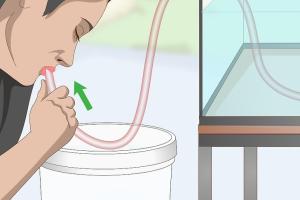Mastering the Art of Siphoning Water: A Comprehensive Guide

-
Quick Links:
- 1. Introduction
- 2. What is Siphoning?
- 3. How Siphoning Works
- 4. Tools and Materials Needed
- 5. Step-by-Step Guide on How to Siphon Water
- 6. Common Mistakes to Avoid
- 7. Case Studies and Practical Applications
- 8. Expert Insights on Siphoning Water
- 9. Siphoning in Different Situations
- 10. FAQs
1. Introduction
Siphoning water is a skill that can be incredibly useful, whether you're maintaining an aquarium, watering your garden, or transferring liquid between containers. This technique, which relies on gravity and atmospheric pressure, allows you to move water without the need for a pump. In this comprehensive guide, we will explore the intricacies of siphoning, providing you with the knowledge and tools necessary to master this art.
2. What is Siphoning?
Siphoning is a method of transferring liquid from one container to another using a tube. The process takes advantage of the differences in height between the source container and the receiving container. By creating a vacuum or using gravity, the liquid flows from the higher container to the lower one.
3. How Siphoning Works
The principle behind siphoning is based on two forces: gravity and atmospheric pressure. When you fill a tube with liquid and place one end in a higher container and the other in a lower container, gravity pulls the liquid down. The atmospheric pressure on the liquid in the higher container pushes the liquid into the tube, creating a continuous flow.
4. Tools and Materials Needed
To siphon water effectively, you'll need some basic tools and materials:
- Siphon Tube: A clear plastic or rubber tube, typically 1/2 to 1-inch in diameter.
- Containers: Two containers of different heights (e.g., buckets, tanks).
- Water Source: The source from which you will siphon water.
- Clamps (optional): To secure the tube in place.
5. Step-by-Step Guide on How to Siphon Water
Now that you have the necessary tools, follow these steps to successfully siphon water:
- Set Up Your Containers: Place the source container at a higher elevation than the receiving container.
- Fill the Tube with Water: Submerge the siphon tube in the source container, allowing it to fill completely.
- Block One End: Cover one end of the tube with your thumb to create a seal.
- Move the Tube: While keeping the thumb over the end, quickly move the tube to the lower container.
- Release Your Thumb: Once the tube is positioned correctly, remove your thumb to allow the water to flow.
6. Common Mistakes to Avoid
While siphoning may seem simple, beginners often make mistakes. Here are some common pitfalls:
- Not filling the tube completely before starting the siphon.
- Using a tube that is too long or too narrow for the task.
- Positioning the containers incorrectly, leading to a failed siphon.
7. Case Studies and Practical Applications
Let’s examine a few practical applications of siphoning in real-world scenarios:
Case Study 1: Aquarium Maintenance
A hobbyist uses siphoning to perform regular water changes in their aquarium. By siphoning out old water and replacing it with fresh water, they maintain a healthy environment for their fish.
Case Study 2: Gardening
A gardener uses siphoning to transfer water from a rain barrel to their garden beds, efficiently utilizing collected rainwater for irrigation.
8. Expert Insights on Siphoning Water
Experts emphasize the importance of understanding the siphoning process fully. According to Dr. Jane Doe, a fluid dynamics expert, “Understanding the physics behind siphoning is crucial for effective water transfer. It enables users to troubleshoot any issues that may arise.”
9. Siphoning in Different Situations
Siphoning can be applied in various situations beyond gardening and aquariums:
- Emergency Water Removal: Use siphoning to remove water from flooded areas.
- Home Brewing: Siphon beer or wine during the bottling process.
10. FAQs
FAQs
1. Can I siphon water using a garden hose?
Yes, a garden hose can be used for siphoning, but ensure it's clean to avoid contaminating the water.
2. What is the best material for a siphon tube?
Clear plastic or rubber tubes are ideal as they are flexible and allow visibility of the water flow.
3. How do I create a vacuum in the siphon tube?
Fill the tube completely with water and cover one end while moving it to the lower container.
4. Is siphoning safe for drinking water?
Yes, as long as the tube is made of food-safe materials and is clean.
5. How do I know if my siphon is working?
If water begins to flow steadily from the lower end of the tube, your siphon is working correctly.
6. Can I siphon liquids other than water?
Yes, but be cautious with hazardous liquids. Ensure the siphon tube is compatible with the liquid being siphoned.
7. What if the siphoning stops unexpectedly?
Check for blockages in the tube or ensure that the source container is still higher than the receiving container.
8. How long can I siphon for?
You can siphon as long as you maintain the height difference and the source container has liquid.
9. Can I use a pump instead of siphoning?
Yes, pumps can be used, but siphoning is often simpler and more cost-effective for small tasks.
10. What are some advanced siphoning techniques?
Advanced techniques include using multiple tubes for simultaneous siphoning or creating a continuous flow system for larger projects.
Random Reads